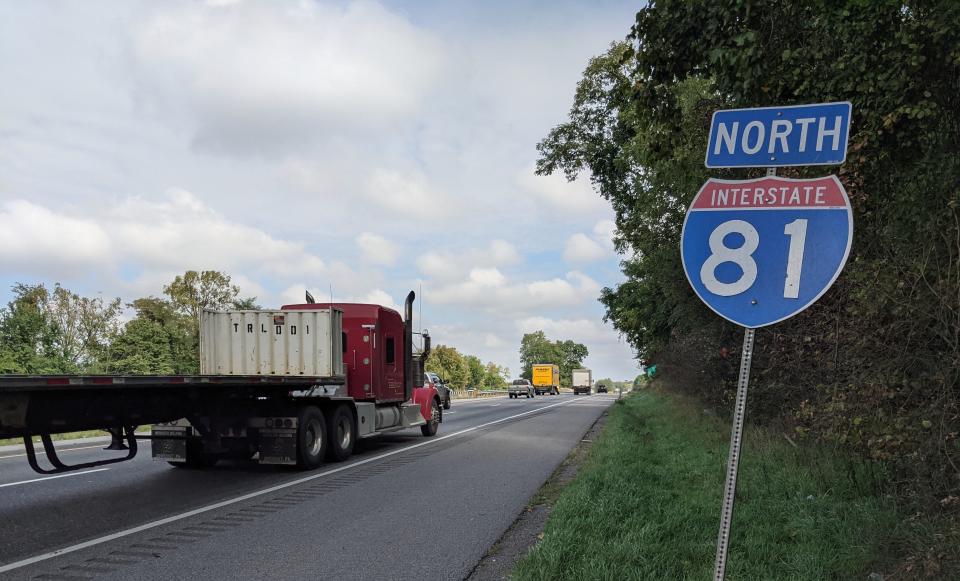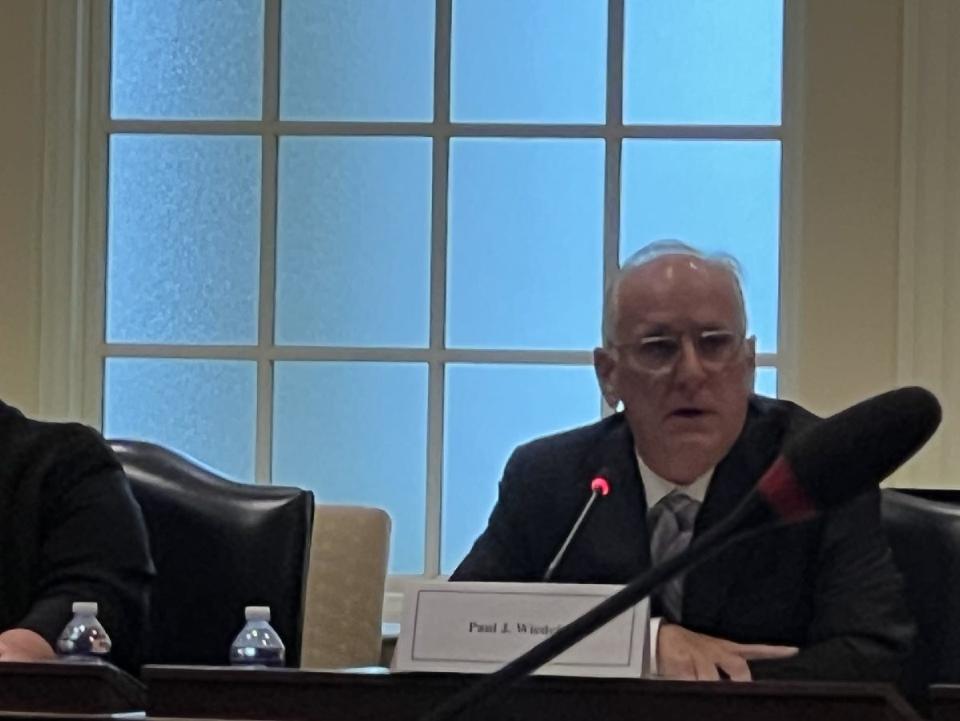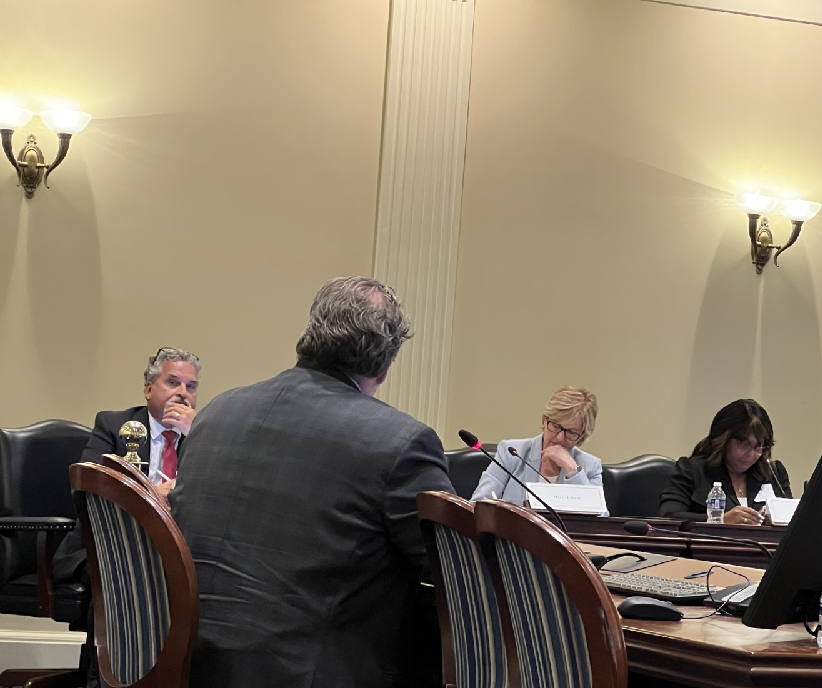With gas tax revenue diminishing, Maryland commission meets to find new revenue for roads
Correction: A previous version of this article contained incorrect information about the total amount of predicted lost revenue from the gas tax in Maryland. The figures presented are the predicted loss in revenue from the gas tax for all 50 states combined. Motor fuel tax revenue in Maryland was about $1.1 billion in fiscal year 2022. The Herald-Mail apologizes for the error.
Maryland’s governor has set a pair of ambitious transportation-related goals: phasing out the sale of gas-powered vehicles by 2035 and lessening the toll of the gas tax on working families, but the rubber meets the road, so to speak, when it comes to one word: revenue.
For decades, maintenance and improvements to the state’s roads, bridges, and other transportation projects have been paid for by the Transportation Trust Fund, the largest sources of which are the gas tax and vehicle registrations.
But with fuel efficiency increasing and nine times the number of electric vehicles on Maryland’s roads since 2016, the state is seeking solutions on how to pay for transportation projects as gas consumption dwindles. On Thursday, the extent of the problem was made clear in Annapolis during the first meeting of a newly authorized commission.
“In short, the days of the motor fuel tax as the primary source of funding for transportation are numbered,” Transportation Consultant Ed Regan told members of the Commission on Transportation Revenue and Infrastructure Needs, a group set up by state law earlier this year.

More: In Ocean City address, Moore declares 'new season of challenge' for Maryland economy
The 30-plus member commission is charged with “reviewing revenue trends that demonstrate weaknesses in the stability of the Trust Fund” and providing options for “sustainable, long–term revenue sources for transportation,” among other provisions of the law, co-sponsored by state Sen. Paul Corderman, R-Washington/Frederick, a member of the Budget and Taxation Committee.
‘Time is running out’ on gas tax revenue
Regan’s presentation, one of six during the three-hour meeting, delved into the scope of the shortfall.
With even a moderate or middle level of adoption of electric vehicles, Regan said, the state is predicted to have a 17.5% reduction in revenue from the fuel tax by 2030. The presentation titled, “The Gas Tax in America: Time is Running Out,” shows this reduction equating to a predicted $12.4 billion in lost revenue for all 50 states.
A high level of adoption of environmentally friendly electric vehicles would yield an even greater predicted loss. By mid-century, over half of the states’ gas tax revenues would be gone. The yawning gap showed in Regan’s presentation predicted $43.7 billion in lost revenue for all 50 states.
More: Gun laws, wind energy hot topics as General Assembly wraps up Gov. Wes Moore's 1st session

State Transportation Secretary Paul Wiedefeld urged the commission in his closing remarks to “not look for a quick fix,” but his introductory remarks demonstrated some of the reasons that the lost revenue is vital for Marylanders across the state.
In addition to the recently announced revitalization of the Red Line in Baltimore, he highlighted “improving the safety of I-81” as one of a few of the state’s current transportation projects.
The highway, which runs a little more than 12 miles in Maryland, is scheduled to be widened by one lane in each direction in a 3.5 mile stretch between Md. 63/Md. 68 (Lappans Road) near Williamsport to the CSX bridges north of Halfway Boulevard at a cost of over $100 million.
According to the state’s consolidated transportation plan updated this year, construction is not scheduled to begin until the 2026 fiscal year, which starts July 1, 2025.
More: The road for I-81 funding continues with new administration, transportation secretary
Public transportation passenger fare also declining, expert says

Jim Kercheval, the executive director of the Greater Hagerstown Committee who is serving on the commission, had a question during the meeting regarding yet another revenue source showing decline, funds from public transit passenger fare.
REVIEW: Gas prices finally fall below $3 in parts of Maryland. What about tax?
“What is your industry doing to adjust to that change in how people work?” Kercheval asked of Ward McCarragher of the American Public Transportation Association.
McCarragher’s presentation showed a steep pandemic-related dropoff in passenger fare revenue and a looming fiscal cliff for most public transportation agencies by fiscal year 2028.
“We have many agencies that are more than 100% of what they were, pre-COVID,” said McCarragher. “It’s somewhat community dependent,” he said, noting not all riders have come back to D.C. where he works.
In June, rail ridership was at about 50% of pre-pandemic levels on weekdays, according to data from the Washington Metropolitan Area Transportation Authority, or Metro.
Maryland contributed over $400 million in subsidies this year to the Washington Metropolitan Area Transportation Authority, which Wiedefeld once led as general manager and CEO.
Federal funds from Bipartisan Infrastructure Law still coming to state
One source of funding that is not projected to taper off in the short term are federal funds, which are allocated as a result of the Bipartisan Infrastructure Law passed and signed into law by President Joe Biden in November 2021.
The law paid for about 90% of the I-81 improvements.
In May, the federal Department of Transportation announced nearly $12 million from the law would go to improvements for Maryland’s main part of Route 50, which runs from Prince George’s County outside Washington, D.C. to Ocean City on Maryland’s Eastern Shore.
More: Route 50 getting big improvements with infrastructure law: Here's what's in works
Commissioner Patricia Stevens, co-chair of the Worcester County Bicycle and Pedestrian Coalition, asked a Maryland Department of Transportation representative if the department was looking at pursuing federal funds for disadvantaged communities on the Lower Shore, which would not require a state match, such as reconnecting communities split by Route 50 or 113.
The representative said the department was considering that, asking Stevens for projects of which to be aware.
Another use of transportation funds from the Bipartisan Infrastructure Law that was mentioned during the meeting is $50 million allocated for a national roadway user charge pilot program, said Regan, the transportation consultant.
This program, he said, could help shape the way roadway user charges are done, making the fees more equitable for individuals. He cited Cumberland as a locale where people currently contribute to public transit through the federal gas tax, but don’t reap the benefits of those funds with major public transit projects in their area.
More: Maryland moves forward with Gov. Wes Moore during first 100 days as bills get signed
Regan, who warned time was running out on the gas tax revenue, called the moment “very, very critical.”
The commission is scheduled to deliver an interim report to the governor and Legislature on or before Jan. 1, with a final report due on or before Jan. 1, 2025.
The commission’s next meeting is scheduled for Sept. 13, 2023.
Dwight A. Weingarten is an investigative reporter, covering the Maryland State House and state issues. He can be reached at dweingarten@gannett.com or on Twitter at @DwightWeingart2.
This article originally appeared on Salisbury Daily Times: Gas tax cash diminishing; group meets to find new revenue for roads

